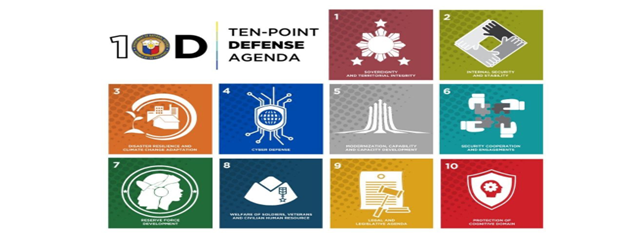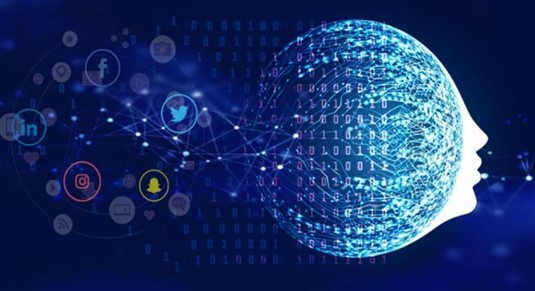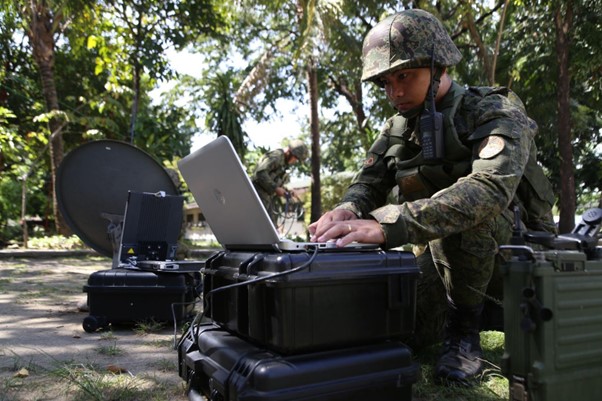By Philip R. Fortuno, PhD
Not long ago, conflicts —especially between states— were limited to using arms and kinetic force to inflict physical damage to one another. It was a time when battles and wars were fought and won by those with the most sophisticated armaments and the most significant number of skilled soldiers. Superiority was fought for on land, sea, and air.
In the past few decades, things have radically changed. Conflicts have become less and less about kinetic force, essentially shifting the domain of operations from physical to metaphysical spheres. State and non-state actors are now fighting for superiority beyond land, sea, air, and space. Many are aggressively exploiting technology to devise more ways to inflict harm on one another, defiant of previously existing physical limitations and barriers to warfare. Thus, for a country’s military to be multi-mission ready and cross-domain capable, it must have a profound understanding of emerging threats and the evolving global security environment.
The Emerging Challenge
One manifestation of these mutations in the nature of warfare is the emergence of cyberspace as a domain of operations. In 2016, the North Atlantic Treaty Organization (NATO) officially recognized cyberspace as the fifth domain, cognizant of the ability of forces to operate within the information environment. What was once in the pages of dystopian novels became a reality, now a series of codes spread to networks of computers can paralyze and shut down infrastructures, companies, and nations.
However, recent developments in warfare present a far more concerning trend and challenging situation. In addition to the domains of land, maritime, air, space, and cyberspace, the human mind has become a neoteric battlefield. The cognitive domain, a boundless and conscious sphere of human activity centered on the act of thinking emanating from the human mind, is emerging as the sixth domain of operations where forces maneuver to attain their strategic interests and agenda. It must be fathomed that every action undertaken in the five domains is designed and executed to have an impact on the cognitive domain of the target person or group.
Understanding the Cognitive Domain
The cognitive domain is referred to as the “thinking domain,” which deals with how a person acquires, processes, and uses knowledge in any given situation. It also involves the recall or recognition of specific facts, procedural patterns, and concepts that develop intellectual abilities and skills such as problem-solving, memory and recall, comprehension, reasoning, and judgment. According to Bloom (1956), the cognitive domain includes the six major categories and they are as follows:
Categories of Intellectual Abilities and Skills
|
CATEGORY (Ranked from Simplest to the Most Complex Behavior) |
| 1. Knowledge - Recall data or information. |
| 2. Comprehension - Understand the meaning, translation, interpolation, and interpretation of instructions and problems. State a problem in one's own words. |
| 3. Application - Use a concept in a new situation or unprompted use of an abstraction. Applies what was learned in the classroom to novel situations in the workplace. |
| 4. Analysis - Separates material or concepts into parts so that its organizational structure may be understood. Distinguishes between facts and inferences. |
| 5. Synthesis - Builds a structure or pattern from diverse elements. Put parts together to form a whole, emphasizing creating a new meaning or structure. |
| 6. Evaluation - Make judgments about the value of ideas or materials. |
The cognitive domain of operations uses human cognition or mental processes as a medium to accomplish missions and exercise control over an opponent. With the advent of modern technology, particularly cognitive technologies, the cognitive domain or human cognition has become a neoteric space for warfare. Recognizing that this closely involves the assiduous use of psychological, information, and communication tactics to attack, with the aid of sophisticated modern technology, a target individual or society without physical contact. This prospect is highly dangerous as it allows an aggressor or any malicious actor to conduct operations that are not easily detected by physical means, such as through cyber attacks, disinformation campaigns, and psychological operations. Cognitive aggression is often used to gain an advantage in the information battle space by using tactics to influence public opinion and disrupt the adversary’s decision-making process. According to Zheng (2014), a Chinese scholar, there are four tactics to win “mind superiority” in the cognitive domain. These are (1) “Perception manipulation” through propaganda narratives; (2) “Cutting off historical memory” so that targets will be open to new values; (3) “Changing the paradigm of thinking” by targeting elites to change their ideology; and (4) “Deconstructing symbols” to challenge national identity, which is what binds a nation. Thus, destroying national identity would likely destabilize a nation or a targeted society.
Aggression in the cognitive domain is the phenomenon of cognitive warfare. It attempts to manipulate the human mind and alter its mental processes to shape the person’s perception or the collective perception of a community to establish a predetermined idea or belief. However, the definition of cognitive warfare was further operationalized by referring to it as manipulating the public discourse by external elements seeking to undermine social unity or damage public trust in the political system — this makes cognitive warfare more thought-provoking. Nevertheless, while cognitive warfare is difficult to define, the following may be considered the key features of cognitive warfare:
Key Features of Cognitive Warfare
| 1. Nature | It is an act to alter a person’s perception and way of thinking. |
| 2. Purpose | The goal is to achieve a strategic interest or agenda. |
| 3. Method | It employs a method that exploits the limitations and vulnerabilities of the human mind. |
| 4. Technology | Technology is used as an aid. |
| 5. Target | It targets the entire population and not just the group’s leaders. |
*Author's elaboration
To understand the nature of the cognitive domain, it is necessary to differentiate cognitive warfare from information operations, which military forces have been engaging in for decades. While both phenomena essentially involve handling information, the latter only refers to controlling its flow to influence the decision-making of the opponent’s leadership. This contrasts with cognitive warfare, where there is an intentional manipulation of information, which is then transformed into knowledge through the processes inherent in the human mind, targeting the entire population. Cognitive warfare is a mission by itself, that is, to achieve a strategic interest and agenda, while information operations are employed primarily to support other military missions.
Difference between Information Operations and Cognitive Warfare
| Parameters | Information Operations (IO) | Cognitive Warfare (CogWar) |
| Method | The flow of information is controlled. | Falsities are transformed into knowledge through the processes inherent in the human mind. |
| Purpose | To gain a competitive advantage against an opponent; to support other missions. | To alter the opponent's perception and way of thinking to achieve a strategic interest or agenda (i.e. political success). |
| Target | It targets the opponent's leadership. | It targets the entire population; does not distinguish between war and peace. |
| Duration | It is often short-term to support a specific traditional mission of the military. | It is often long-term and strategic. |
*Author's Elaboration
The Menace of Cognitive Warfare
Although persuasion and influence have always been vital in warfare, cognitive warfare is an entirely new breed of threat. It aims to deprive the target of their autonomy over their values, beliefs, perception, and actions. This is made possible not only by technological advancements but also by behavioral psychology and neuroscience discoveries that enable examining and mapping an individual's responses to various types of external stimuli. Add that to the abundance of personal information online that allows aggressors to understand the psychology of their target, predict their reactions, and develop their empathy.
Simulation and dissimulation are the most common method of cognitive manipulation. The former is the perpetuation of falsities, and the latter is the concealment of reality. A form of simulation known to many is disinformation through the proliferation of fake news. Aggressors, or actors, utilize social media to alter public discourse through the targeted and systematic release of fabricated information. Table 4 shows the common methods of cognitive manipulation:
Common Methods of Cognitive Manipulation
SIMULATION: Showing the False
| Approaches | Method |
| Mimicking | To recreate an old pattern, imitating it. |
| Inventing | To create a new pattern. |
| Decoying | To give a different, alternative pattern increasing its certainty. |
DISSIMULATION: Hiding the Real
| Approaches | Method |
| Masking | To eliminate an old pattern or blend it with a background pattern. |
| Repackaging | To modify an old pattern by matching another. |
| Dazzling | To blur an old pattern, reducing its uncertainty. |
In the Philippines, violent extremists, terrorists, and groups with political interests have been aiming and working hard to manipulate and radicalize the minds of Filipinos. Through disinformation, they trigger discontent and resentment towards the government and the duly constituted authorities, aside from deliberately sowing discord among the populace. The case of the student whom the communist terrorist group allegedly recruited when she was still a minor can be considered an example of cognitive manipulation.
Similarly, there have also been reported instances of cognitive warfare in some countries. The reported cases of cognitive manipulation include attempts to influence election results, disrupt alliances, magnify geopolitical competition, and justify the illegal use of force under international law. Reportedly, the ongoing conflict between Ukraine and Russia is replete with “intensive use of influence operations which form the cognitive warfare.” Likewise, China is reported to have conducted cognitive warfare against Taiwan through the years. According to Hung and Hung (2022), China's cognitive operations can be sorted into four main categories: (1) military intimidation, (2) influence via bilateral exchange, (3) religious interference, and (4) disinformation and content farms on the internet. Military threats have been China’s most direct way to psychologically manipulate Taiwanese perceptions on the issue of unification, as it has a long history of threatening to take Taiwan by force if it pursues independence.
The danger of cognitive warfare cannot be understated. When committed against a nation or nation-state, cognitive warfare not only discredits the administration or government’s legitimacy in the eyes of everyone but also weakens the people’s will to fight, which is key to a nation's ability to persist in a complex and tense security environment. Cognitive warfare targets collective values essential in preserving and upholding the national identity that binds all citizens of a country –this prospect can break apart a nation.
The Philippines appears to be vulnerable to cognitive warfare. For one, it is a democratic state where freedom of speech and information is constitutionally protected. Opposed to authoritarian states where the flow of certain information may be restricted, the flow of information in the Philippines is relatively unobstructed, which makes it susceptible to interference and distortion by organized misinformation and disinformation efforts. Cognitive aggressors view the openness of the Philippines to public discourses as an opportunity for them and a weakness of the state. This apparent vulnerability is aggravated by the populace's widespread use of social media. Recent and current data shows that social media has become a hotbed of misinformation and disinformation. Thus, given the trend, around 84.07 million Filipinos, as of July 2022, are users of various social networks, which is expected to balloon further to over 91 million by 2026.
Addressing the Threat
What could be done moving forward? There must be purposive efforts for national awareness of cognitive aggression or warfare, particularly its nature, ubiquity, and virulence. Filipinos must realize the utmost importance and necessity of protecting the integrity of their minds and mental processes. With the commonness of modern technology in our midst, cognitive warfare will only intensify in the days to come. To quote Michael Mazarr, a political scientist: “New tools and techniques, combined with the changing technological information foundation of modern societies, are creating an unprecedented capacity to conduct societal warfare.”
Protecting the Philippines’ cognitive domain is a shared responsibility between the government and its people. As such, there must be a whole-of-government and whole-of-nation approach that is deliberate and comprehensive to counter attempts against the integrity of the nation’s cognitive domain. Coherent and factual narratives must be developed and propagated to neutralize corrupted and manipulative information in the public sphere. The words of authors Claverie and Cluzel (n.d.) remind us: “Cognitive warfare is now with us. The main challenge is that it is essentially invisible; all you see is its impact and by then… it's often too late.”
The mind is the standard of man. Whatever the mind conceives and processes leaves a mark on the person's consciousness or subconsciousness. Failure to effectively address attacks on the cognitive domain has a lasting impact on our dignity as human beings and our strategic direction as a sovereign country. Hence, the Department of National Defense (DND) endeavors to protect the Philippines’ cognitive domain, appositely articulated in the Department’s Ten-Point Defense Agenda or the 10D. The other nine priorities of the Agenda include: (1) Sovereignty and Territorial Integrity, (2) Internal Security and Stability, (3) Disaster Resilience and Climate Change Adaptation, (4) Cyber Defense, (5) Modernization, Capability, and Capacity development, (6) Security Cooperation and Engagements, (7) Reserve Force Development, (8) Welfare of Soldiers, Veterans, and Civilian Human Resource, and (9) Legal and Legislative Agenda. The 10D is the Defense Department’s strategic thrust to actualize its mandate and support a peaceful, progressive, and prosperous Philippine society.
In sum, the key to protecting the Philippines' cognitive domain and developing a resilient nation from a host of security threats is to have a discerning, patriotic, and well-informed citizenry. Every peace-loving Filipino must understand that wars start in the mind. Hence, we must keep the mind free from perversion and manipulation. To do so, there is a need to encourage, support, and sustain activities that reinforce our dignified Filipino heritage, alongside efforts that enhance our national defense initiatives, and programs that contribute to the strategic development of a national security mindset.
ABOUT THE AUTHOR
PHILIP R. FORTUNO, PhD, is a 1995 graduate of the Singapore Armed Forces Training Institute (SAFTI) and the author of several books on defense and security. Dr. Fortuno is a longtime advocate of sustainable peace and inclusive development.
REFERENCES
Bilal, A. (2021). Hybrid Warfare – New Threats, Complexity, and ‘Trust’ as the Antidote. Retrieved October 21, 2022, from https://www.nato.int/docu/review/articles/2021/11/30/hybrid-warfare-new-threats-complexity-and-trust-as-the-antidote/index.html
Bloom, B. (1956). Bloom's Taxonomy of Learning Domains. Retrieved September 27, 2022, from https://vikaspedia.in/education/teachers-corner/bloom-s-taxonomy-of-learning-domains
Claverie, B. and Cluzel, F. (n.d.). Cognitive Warfare: The Future of Cognitive Dominance. North Atlantic Treaty Organization, Science and Technology Organization. Retrieved on November 14, 2022 from https://hal.science/hal-03635889/document
Cluzel, F. (2022). Cognitive Warfare. Retrieved September 29, 2022 from https://www.innovationhub act.org/sites/default/files/2021 01/20210113_CW%20Final%20v2%20.pdf
Hung, T.C. & Hung, T.W. (2022). How China's Cognitive Warfare Works: A Frontline Perspective of Taiwan's Anti-Disinformation Wars. Retrieved January 4, 2023 from https://academic.oup.com/jogss/article/7/4/ogac016/6647447
Orinx, K. & Swielande, T. (2022). China and Cognitive Warfare: Why Is the West Losing? Retrieved September 29, 2022, from https://hal.archives-ouvertes.fr/hal-03635930/document
Otewell, P. (2020). Defining the Cognitive Domain. Retrieved October 21, 2022, from https://othjournal.com/2020/12/07/defining-the-cognitive-domain/
Philippine News Agency (PNA). (2020). DILG to Reds: Free AJ Lucena, youth from communist terrorism. Retrieved October 26, 2022, from https://www.pna.gov.ph/articles/1104400
Pradhan, SD. (2022). Role of cognitive warfare in Russia-Ukraine conflict: Potential for achieving strategic victory bypassing traditional battlefield. Retrieved October 26, 2022, from https://timesofindia.indiatimes.com/blogs/ChanakyaCode/role-of-cognitive-warfare-in-russia-ukraine-conflict-potential-for-achieving-strategic-victory-bypassing-traditional-battlefield/
Rosner, Y. & Siman-Tov, D. (2018). Russian Intervention in the US Presidential Elections: The New Threat of Cognitive Subversion. Retrieved September 27, 2022, from http://www.jstor.org/stable/resrep17054
Sternberg, R. (2019). ‘History of the Field of the Psychology of Human Thought,’ in The Psychology of Human Thought: An Introduction, edited by Robert Sternberg and Joachim Funke (Heidelberg: Heidelberg University Publishing, 2019), p. 21.
The NATO Cooperative Cyber Defence Centre of Excellence. (2016). NATO Recognises Cyberspace as a ‘Domain of Operations’ at Warsaw Summit. Retrieved October 30, 2022 from https://ccdcoe.org/incyder-articles/nato-recognises-cyberspace-as-a-domain-of-operations-at-warsaw-summit/
Whaley, B. (1982). Toward a General Theory of Deception in John Gooch and Amos Perlmutter, eds., Military Deception and Strategic Surprise (1982), p. 182.
Zeng, H. (2014). Seizing Mind Superiority in Future Wars, PLA Daily, 16 June 2014, http://www.81.cn/jwgd/2014-06/16/content_5961384.html.
Tsikhelashvili, N. (2022). Influence of Cognitive Warfare on National Will to Fight. Retrieved September 28, 2022, from https://www.thedefencehorizon.org/post/influence-of-cognitive-warfare-on-national-will-to-fight
Statista. (2022). Number of social network users Philippines 2017-2026. Retrieved September 30, 2022, from https://www.statista.com/statistics/489180/number-of-social-network-users-in-philippines/





